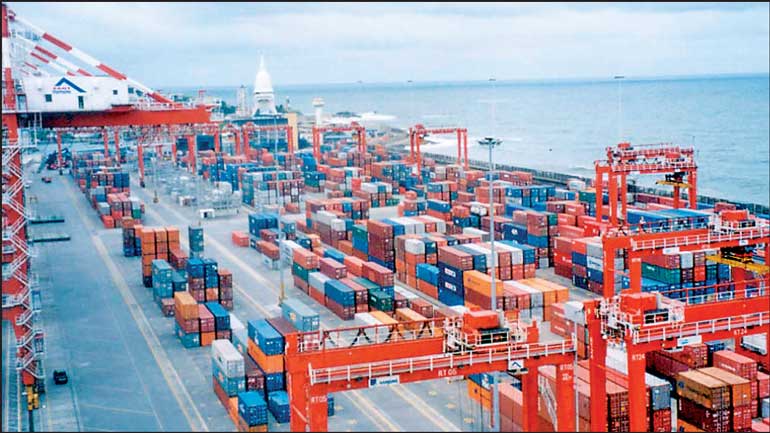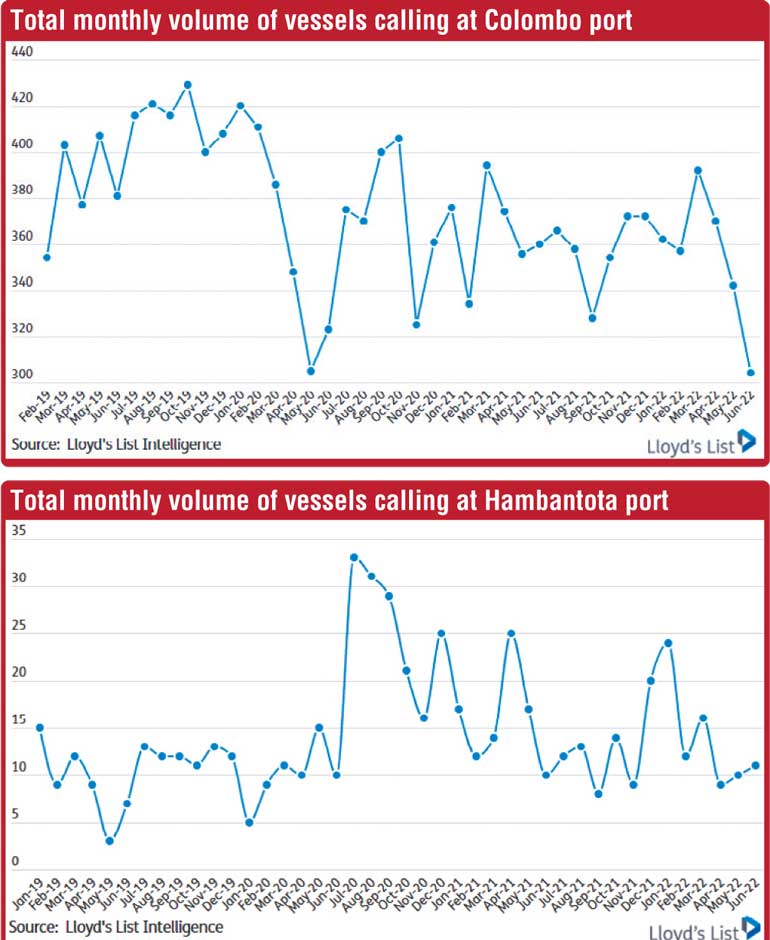Monday Apr 21, 2025
Monday Apr 21, 2025
Monday, 18 July 2022 00:00 - - {{hitsCtrl.values.hits}}


PORT operations at Sri Lanka’s key transhipment hub Colombo have been largely unaffected by the spiralling economic collapse that has triggered widespread protests across the country.
Lloyd’s List Intelligence data confirms local agent assessments that port calls have remained steady throughout the recent political disruption, however volumes have been declining since the beginning of the year.
During the first five months of 2022, export volumes have dipped by 1.8%, while import volumes are down 11.9%, largely as a result of restrictions imposed by the Government on the importation of items in response to the country’s severe foreign exchange crisis.
The Sri Lanka Ports Authority has required container lines calling at the country to pay their dues in US dollars rather than in Sri Lankan rupees since June, however such restrictions have not interrupted the lines’ operations.
Ring-fenced fuel reserves dedicated to the port have sustained power throughout rolling power grid blackouts across the country amid widespread fuel shortages.
The number of containerships calling at Colombo has dipped by 2.7% so far this year. However, that decline has largely been attributed to vessels being delayed at other ports and skipping Colombo on catch-up schedules or lines blanking entire services.
Despite several local news and social media reports suggesting that container lines have been shifting their transhipment volumes to South Indian ports, there is little evidence to support those claims.
“While a few lines have pulled out a few services due to operational reasons or restructuring of services, the port of Colombo has not seen any alarming decline in the services calling at Colombo,” explained local Lloyd’s agent Joel Rajasooriyar.
“Interterminal transfers, especially connecting the transhipment containers, is being done without any interruption and there have not been any missed connections once containers are landed in the port,” Rajasooriyar told Lloyd’s List.
Amid crushing debt and sky-high inflation, the country has run out of US currency to pay for imports of basic goods, leaving citizens waiting for hours to buy fuel and major cities scrambling to keep the lights on.
With around $ 35 billion in foreign debt, Sri Lanka is the first Government in the Asia-Pacific region to default on its international obligations since Pakistan in 1999.
Negotiations for a bailout from the International Monetary Fund are now under way. However, even if a politically stable Government can be formed in order to meet the required conditions for funding, years of painful austerity measures now await Sri Lanka.
Much of the current economic turmoil can be traced back to years of politically misjudged investment, including the ill-fated vision of Mahinda Rajapaksa, who served as Sri Lanka’s President from 2005 until 2015 and is a brother of the recently deposed leader.
His flagship infrastructure project to transform the southern coastal city of Hambantota, his family’s hometown, into a port city to rival the well-established transhipment hub of Colombo racked up generational levels of debt from China.
Developed as part of the near $ 12 billion of infrastructure investment loans extended to Sri Lanka by China between 2000 to 2020, Hambantota did not make enough revenue to service its debt and was sold back to China Merchants in 2017 on a 99-year lease.
Despite plans to invest in the port, the volume of vessel traffic calling at the deepwater port has never exceeded more than 33 vessels in a single month since it opened.
Discover Kapruka, the leading online shopping platform in Sri Lanka, where you can conveniently send Gifts and Flowers to your loved ones for any event including Valentine ’s Day. Explore a wide range of popular Shopping Categories on Kapruka, including Toys, Groceries, Electronics, Birthday Cakes, Fruits, Chocolates, Flower Bouquets, Clothing, Watches, Lingerie, Gift Sets and Jewellery. Also if you’re interested in selling with Kapruka, Partner Central by Kapruka is the best solution to start with. Moreover, through Kapruka Global Shop, you can also enjoy the convenience of purchasing products from renowned platforms like Amazon and eBay and have them delivered to Sri Lanka.
Discover Kapruka, the leading online shopping platform in Sri Lanka, where you can conveniently send Gifts and Flowers to your loved ones for any event including Valentine ’s Day. Explore a wide range of popular Shopping Categories on Kapruka, including Toys, Groceries, Electronics, Birthday Cakes, Fruits, Chocolates, Flower Bouquets, Clothing, Watches, Lingerie, Gift Sets and Jewellery. Also if you’re interested in selling with Kapruka, Partner Central by Kapruka is the best solution to start with. Moreover, through Kapruka Global Shop, you can also enjoy the convenience of purchasing products from renowned platforms like Amazon and eBay and have them delivered to Sri Lanka.